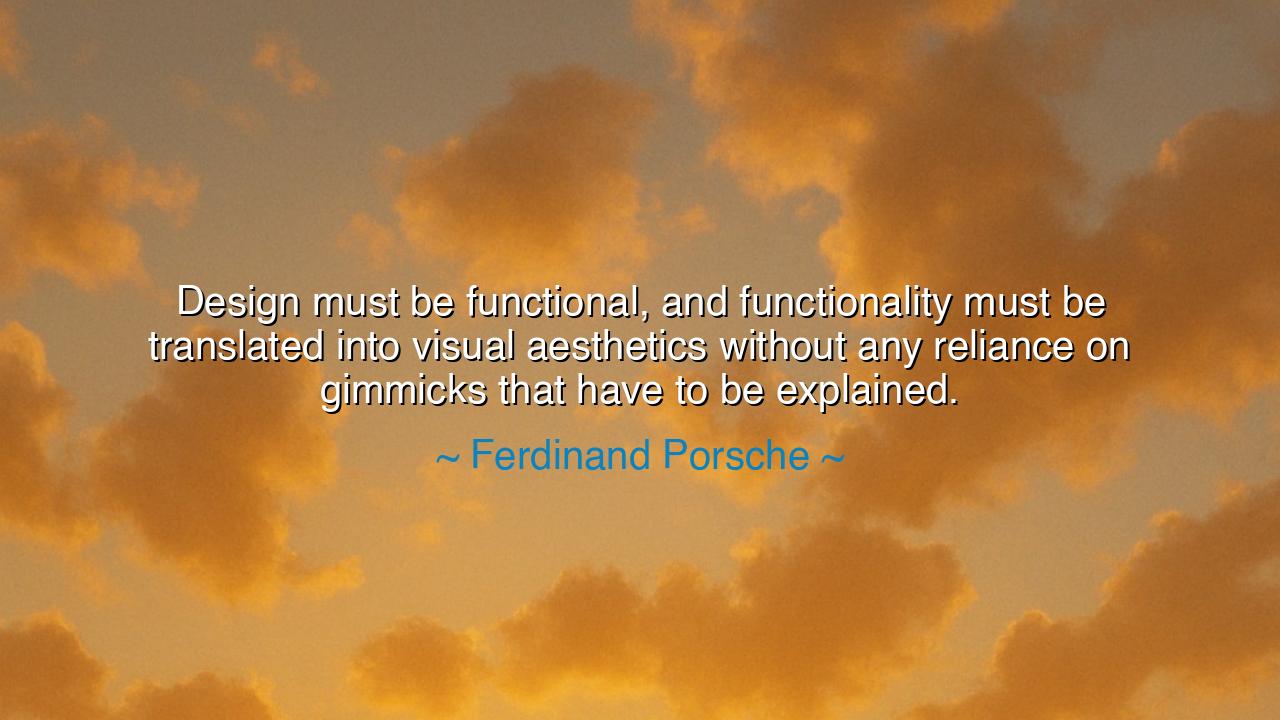
Design must be functional, and functionality must be translated
Design must be functional, and functionality must be translated into visual aesthetics without any reliance on gimmicks that have to be explained.






The words of Ferdinand Porsche, the master craftsman of motion, resound like a chisel striking marble: “Design must be functional, and functionality must be translated into visual aesthetics without any reliance on gimmicks that have to be explained.” In this declaration lies the creed of all true creators — that beauty and purpose must be one, that form and function are but two faces of the same divine truth. Porsche, whose hands and mind shaped the enduring spirit of the automobile, spoke not only to engineers, but to all who dare to bring something into being. His words remind us that design, like character, is hollow if it hides behind ornament and illusion.
In the world of creation, there are two paths. One dazzles with spectacle — empty forms meant to seduce the eye but serve no purpose. The other, rarer path seeks harmony, where beauty arises naturally from the honest performance of function. Porsche, like an ancient philosopher of craftsmanship, chose the latter. He believed that a thing must first be useful, must first fulfill its purpose with grace and clarity. Only then does beauty emerge — not forced, not decorated, but born as effortlessly as the curve of a leaf or the arc of a wave. For what is truly functional is already beautiful; nature has always known this law.
Consider the legend of the Porsche 356, the first car to bear his family’s name. It was not adorned with extravagance, nor embellished with needless details. Every curve, every line, was born of necessity — the pursuit of aerodynamic perfection, of lightness, of speed married to control. The car did not demand that anyone explain its form; it spoke for itself, as all great designs do. When seen, it stirred emotion; when driven, it revealed its soul. This is what Porsche meant — that true design communicates without words, that it transcends explanation because it embodies clarity of purpose.
Throughout history, the greatest creations have followed this same principle. The Parthenon in Athens, the Japanese katana, Leonardo’s flying machines — each was a union of purpose and beauty, where form served function, and in doing so, became eternal. The ancients never separated usefulness from elegance; they understood that art and engineering were siblings, born of the same divine curiosity. To them, perfection was not a matter of decoration, but of proportion, balance, and truth. Porsche inherited this ancient wisdom, and through the language of metal and motion, passed it to the modern age.
But the world is often tempted by gimmicks, by the shallow desire to impress rather than to serve. How many creations today must be explained before they are understood? How many things appear clever, yet fail to endure? Porsche’s warning is timeless — that when art forgets its purpose, it dies; when design forgets function, it deceives. True design, like true character, requires no justification. It speaks with the silent eloquence of something that simply works, something that fulfills its role in the grand order of things.
So, let every craftsman, every dreamer, every builder remember this: function is the soul of form. Do not chase beauty for its own sake, for it will elude you. Seek instead to serve — to make something that works with purity and precision — and beauty will arise as naturally as dawn from night. The greatest elegance lies not in excess, but in essence. The more perfectly a thing does what it was made to do, the more divine it becomes.
Let this be your lesson, passed down through the ages: when you create, let honesty be your guide. Strip away what is false. Build what is true. Whether you shape machines, melodies, or ideas, let your work be so pure in purpose that no words are needed to explain it. For in the end, as Ferdinand Porsche knew, the most beautiful design is the one that simply works — effortlessly, eternally, and without need of defense.
And so, future generations, remember this: in your work, in your art, and in your life — make every design, every action, every choice functional, and let that function become your aesthetic truth. In that unity lies not only the mark of great design, but the mark of greatness itself.






AAdministratorAdministrator
Welcome, honored guests. Please leave a comment, we will respond soon